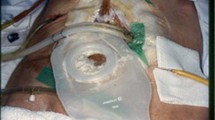Abstract
Enterocutaneous fistulas remain a difficult management problem. The basis of management centers on the prevention and treatment of sepsis, control of fistula effluent, and fluid and nutritional support. Early surgery should be limited to abscess drainage and proximal defunctioning stoma formation. Definitive procedures for a persistent fistula are indicated in the late postoperative period, with resection of the fistula segment and reanastomosis of healthy bowel. Even more complex are the enteroatmospheric fistulas in the open abdomen. These enteric fistulas require the highest level of multidisciplinary approach for optimal outcomes.





Similar content being viewed by others
References
Rutkow IM. Beaumont and St Martin: a blast from the past. Arch Surg. 1998;133:1259.
Vikram K. Enterocutaneous fistula. Available online at: http://emedicine.medscape.com/article/1372132-overview; 2010. Accessed on 26 December 2010.
Chapman R, Foran R, Dunphy JE. Management of intestinal fistulas. Am J Surg. 1964;108:157–64.
Dudrick SJ, Maharaj AR, McKelvey AA. Artificial nutritional support in patients with gastrointestinal fistulas. World J Surg. 1999;23(6):570–6.
Schecter WP, Ivatury RR, Rotondo MF, Hirshberg A. Open abdomen after trauma and abdominal sepsis: a strategy for management. J Am Coll Surg. 2006;203(3):390–6.
Hollington P, Mawdsley J, Lim W, Gabe SM, Forbes A, Windsor AJ. An 11-year experience of enterocutaneous fistula. Br J Surg. 2004;91:1646–51.
Gayral F, Campion JP, Regimbeau JM, Blumberg J, Maisonobe P, Topart P, Wind P; Lanreotide Digestive Fistula. Randomized, placebo-controlled, double-blind study of the efficacy of lanreotide 30 mg PR in the treatment of pancreatic and enterocutaneous fistulae. Ann Surg. 2009;250(6):872–7.
Felley C, Vader JP, Juillerat P, Pittet V, O’Morain C, Panis Y, Vucelic B, Gonvers JJ, Mottet C, Froehlich F, Michetti P; the EPACT II Study Group. Appropriate therapy for fistulizing and fibrostenotic Crohn’s disease: results of a multidisciplinary expert panel—EPACT II. J Crohns Colitis. 2009;3(4):250–6.
Byrnes MC, Riggle A, Beilman G, Chipman J. A novel technique to skin graft abdominal wall wounds surrounding enterocutaneous fistulas. Surg Infect (Larchmt). 2010;11(6):505–9.
Goverman J, Yelon JA, Platz JJ, Singson RC, Turcinovic M. The “Fistula VAC,” a technique for management of enterocutaneous fistulae arising within the open abdomen: report of 5 cases. J Trauma. 2006;60(2):428–31.
Cro C, George KJ, Donnelly J, Irwin ST, Gardiner KR. Vacuum assisted closure system in the management of enterocutaneous fistulae. Postgrad Med J. 2002;78(920):364–5.
Brindle CT, Blankenship J. Management of complex abdominal wounds with small bowel fistulae: isolation techniques and exudate control to improve outcomes. J Wound Ostomy Continence Nurs. 2009;36(4):396–403.
Jamshidi R, Schecter WP. Biological dressings for the management of enteric fistulas in the open abdomen: a preliminary report. Arch Surg. 2007;142(8):793–6.
Dionigi G, Dionigi R, Rovera F, Boni L, Padalino P, Minoja G, Cuffari S, Carrafiello G. Treatment of high output entero-cutaneous fistulae associated with large abdominal wall defects: single center experience. Int J Surg. 2008;6:51–6.
Draus JM Jr, Huss SA, Harty NJ, Cheadle WG, Larson GM. Enterocutaneous fistula: are treatments improving? Surgery. 2006;140(4):570–6.
Martinez JL, Luque-de-Leon E, Mier J, Blanco-Benavides R, Robledo F. Systematic management of postoperative enterocutaneous fistulas: factors related to outcomes. World J Surg. 2008;32(3):436–43.
Fischer PE, Fabian TC, Magnotti LJ, Schroeppel TJ, Bee TK, Maish GO 3rd, Savage SA, Laing AE, Barker AB, Croce MA. A ten-year review of enterocutaneous fistulas after laparotomy for trauma. J Trauma. 2009;67(5):924–8.
Conflict of interest
None.
Author information
Authors and Affiliations
Corresponding author
Rights and permissions
About this article
Cite this article
Whelan, J.F., Ivatury, R.R. Enterocutaneous fistulas: an overview. Eur J Trauma Emerg Surg 37, 251–258 (2011). https://doi.org/10.1007/s00068-011-0097-2
Received:
Accepted:
Published:
Issue Date:
DOI: https://doi.org/10.1007/s00068-011-0097-2




